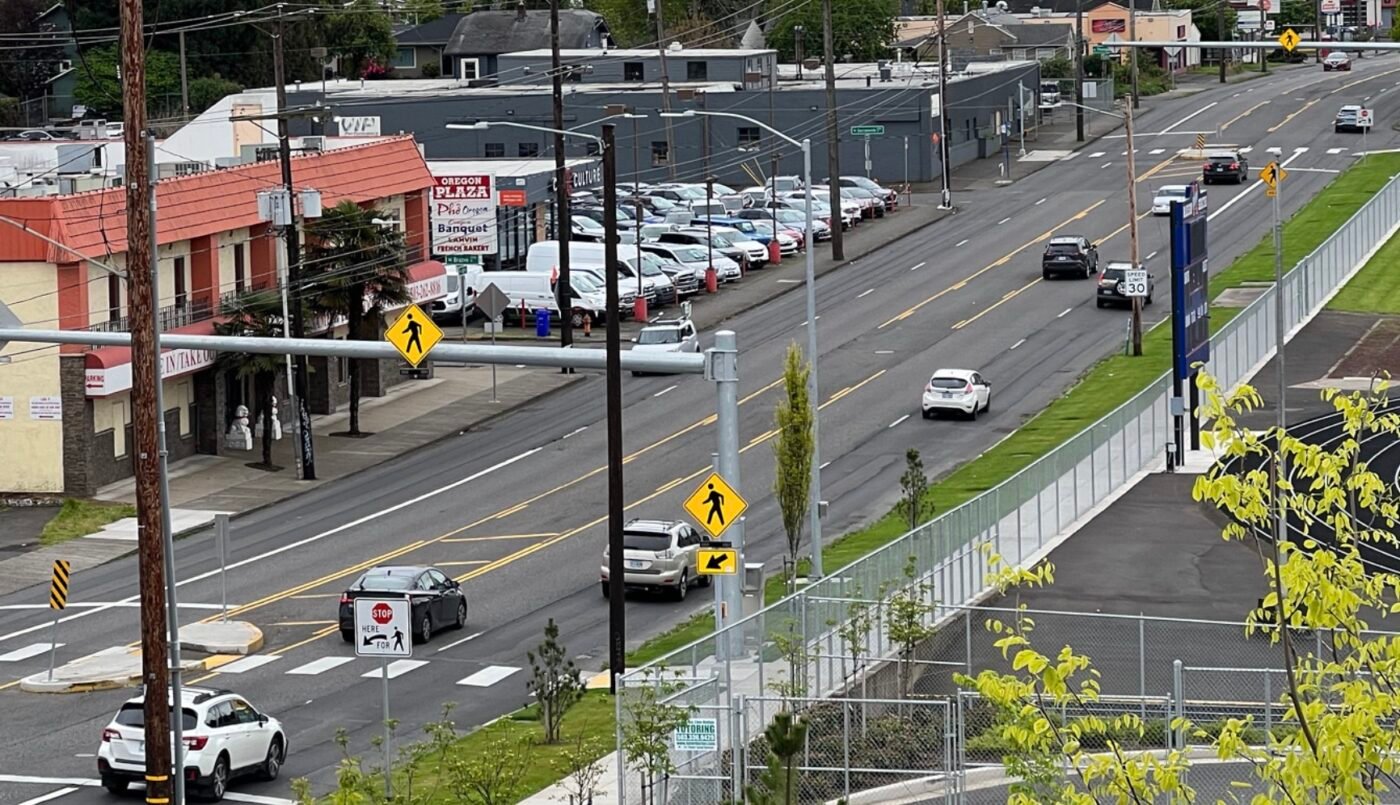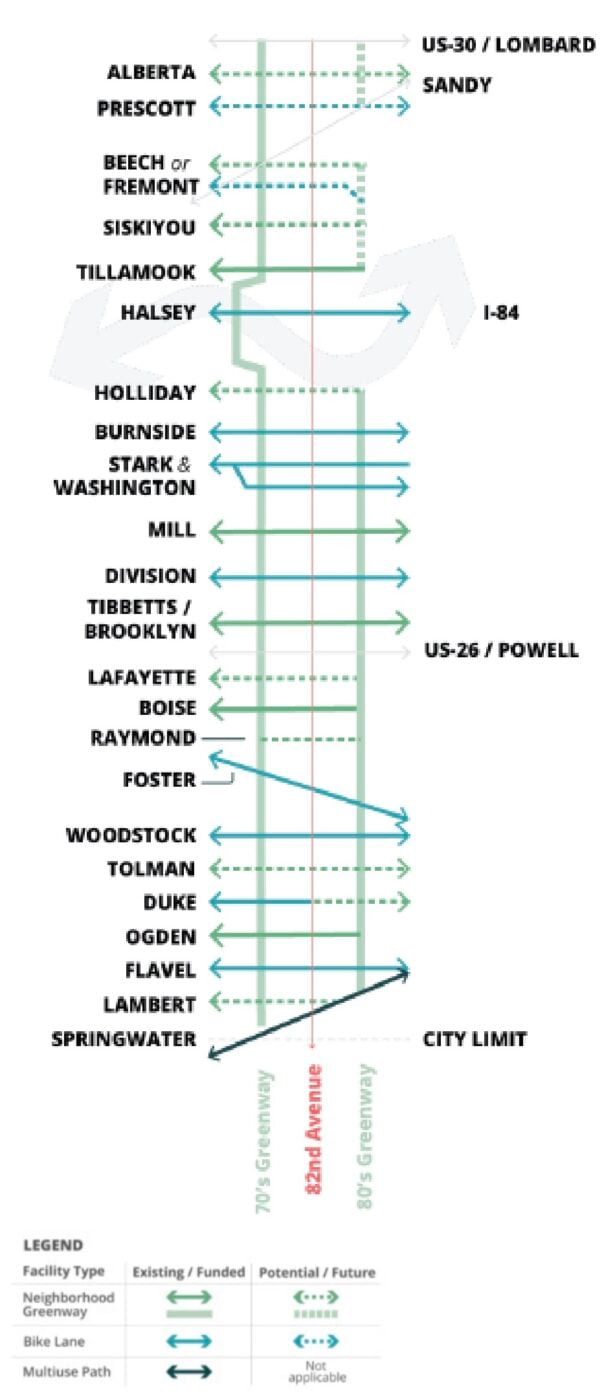
Since March of 2023 (at least) I’ve been trying to help folks understand why the $185 million City of Portland effort to redesign 82nd Avenue wasn’t likely to include bike lanes. Now we know for sure. In documents released this week along with a new open house and online survey, the Portland Bureau of Transportation says the project won’t include space for cycling.
Why not? They say roadway engineering constraints would lead to significant delays for bus and car users. It’s a frustrating, yet completely understandable, conclusion to reach.
Despite the outsized role 82nd plays in the transportation system, in PBOT’s view it’s actually quite narrow. While PBOT was able to build protected bike lanes during recent redesigns of outer SE Stark, SE Division, and SE 122nd, those streets are 10-20 feet wider. Because of that extra width PBOT was, “able to incorporate protected bike lanes without creating major trade-offs for transit and other vehicles,” states a PBOT document published to their website this week.
Given that 82nd carries a high volume of driving trips and is home to the busiest bus line in Oregon, PBOT says, “There is simply not enough space to adequately accommodate all modes of travel” especially since the driver speeds and auto volumes require PBOT to build fully separated, protected bike lanes.
Here’s more from PBOT’s “82nd Avenue Bicycle Strategy”:
“PBOT explored the impact of dedicated bike facilities, focusing on effects on transit and vehicle diversion. Initial modeling showed that even with significant automobile diversion, the Line 72 bus would face major congestion, experiencing about a 50% travel time delay. For example, a 3-mile bus ride on 82nd Avenue would be delayed by an additional 10 minutes, increasing the total travel time to 30 minutes.
Given that Line 72 has higher ridership than the Orange and Yellow MAX lines and currently faces significant delays and reliability issues, the impacts of re-purposing travel lanes for bike facilities are too great.”
What PBOT doesn’t mention is the political risk. I’m not aware of anyone — be it activists or an advocacy group, a community leader or elected official — who’s willing to spend the political capital it would take to get bike lanes on 82nd Avenue. If someone did step up, the bike lanes would be pitted directly against buses, sidewalks, and local business owners. It would risk igniting east Portland narratives about not being listened to by city hall dwellers, the local media would seize on the “bikes versus everyone else” story and we’d be caught in another controversial quagmire. Then there’s the simple fact that bike lanes might not have much support among the many of the interested parties and community groups PBOT has asked for feedback.
The plan instead is to focus bicycle transportation on nearby parallel routes and to improve crossings and access to 82nd.
In their new open house documents, PBOT lists several components of their strategy to improve bike transportation in the corridor:
- Expand the Neighborhood Greenway Network: Enhance and extend the Neighborhood Greenway Network to provide more choices and more effective biking infrastructure in the corridor.
- Improve Bike Connectivity: Strengthen bicycle connections between greenways and key destinations along 82nd Avenue.
- Enhance Wayfinding: Add new wayfinding to improve navigation on existing and future bike routes, ensuring clear guidance to connect people to Neighborhood Greenways and local destinations.
- Enhance Bicycle Parking: Support the development of secure and accessible bicycle parking facilities near affordable housing and other key destinations.
- Review Bicycle Classifications: Assess the bicycle classifications outlined in this plan for consistency and update them as needed in the next Transportation System Plan (TSP) revision.
About half of the planned bike crossings and about three-quarters of the parallel greenway routes are already funded. PBOT calls their robust bike crossing strategy a “bike ladder concept.”
What PBOT doesn’t mention is anything specific about whether or not the future bus lane will explicitly allow bicycling. For riders confident enough, I have a strong hunch the bus lane will become a popular bike route. I currently ride on the red-painted, “Bus Only” lane on NE Martin Luther King Jr. Blvd quite often and find it to be very efficient and convenient (and only a bit unnerving as it has streetcar tracks in it at several junctures).
Given what a vital north-south street this is, and the fact that all our adopted planning goals call for more bicycling and less driving — especially on busy, destination-rich commercial corridors — it’s unfortunate we aren’t willing to sacrifice driving space to create cycling access on 82nd. But I also understand the thorny political and engineering factors behind PBOT’s decision.
— Check out the online open house and link to the new online survey on PBOT’s website.




